#lm ephemera
Text
Life of a Les Mis fan in 1892:

Source: The Adelaide Observer
133 notes
·
View notes
Text
Icarus
There was a time when you found yourself in a place where the impression of great antiquity was joined by others: the impression of endlessness, the sensation of oppressiveness and horror, the sensation of complex irrationality. You had made your way through a dark maze, but it was the bright city of the immortals that terrified and repelled you. A maze is a house built purposely to confuse men; its architecture, prodigal in symmetries, is made to serve that purpose. In the palace that you imperfectly explored, the architecture had no purpose. There were corridors that led nowhere, unreachably high windows, grandly dramatic doors that opened onto monk-like cells or empty shafts, incredible upside-down staircases with upside-down treads and balustrades. Other staircases, clinging airily to the side of a monumental wall, petered out after two or three landings, in the high gloom of the cupolas, arriving nowhere. [1] This place is so horrific that its mere existence, the mere fact of its having endured, pollutes the past and the future and somehow compromises the stars. [2] Within all this a 'garden of light' was created between two concrete walls [3]. This is where in despair a gift has been given to you by love. A gift that should change everything. You rose from the impasse towards the light and what you found is a life of bliss like that before the fall, of eternal youth [4]. But with bliss comes abyss. You fell to the end of your existence and what I want to tell is the thing you have never seen. Thus it takes on an unexpected prophetic dimension. [5]
the light touch. [6]
A last lonely candle wandered up the sky. [7] At first you see only one tiny glowing object, but then a multitude of stars. [8] They floated, fell: they faded [9] in gold glowering light [10] but that night, in that glow, it was the very image of your death. [11] Though for me, watching you fall in light, it is much more than this, approaching an existential experience and attitude: the attitude of loss of reality, of experiencing reality as a dream, a totally de-substantialized flow of fragile and ephemeral appearances, in relation to which I am not an engaged agent, but a stunned passive observer observing my own dream. [12] Similar to moments in which, in a particular emotive situation (an hour of the day, an unexpected event that suddenly fixes our attention on an object), things appear to us in a new light. They do not refer us to a beauty outside themselves, they do not call up any 'correspondence': they appear, simply, with an intensity that was previously unknown to us. [13] And this beauty is beautiful for the very reason that the power of thought cannot inquire of it why it is beautiful. [14] As everything changes when presence is no longer the primary consideration. [15]
reminiscence
The dream you gave remains. I am writing to you from a far distant place where we have created images that do not move, in which light becomes static and time becomes timeless; a world of the immortals. To do so we have launched thousands of times a satellite towards the light. In this world we lost the mysterious (which describes that which is unknown and excites curiosity and perhaps awe) and with it we have lost beauty as we are not looking for a static and harmonious beauty, but a dynamic one, in the process of becoming. [16] One we can feel! Now all those satellites that rose to high die and form a dark maze in which they collide and divide into pieces. But from time to time when they nearly disappeared in their orbits [17] they fall. Many of them of great beauty and to you unknown [18] crystalline slivers, as if some glass lamp had shattered to bits and come raining down from the sky [19]. We would see some object coming at us from the depths of space, flitting about like some bird [20]. Then they'd be lost maybe forever in the dark, empty void. [21]. And I would ask myself; was it you? Did you fall from heaven? [22]
ephemera
[1] Borges CF, [2] Borges CF, [3] ito TIMF, [4] Harrison Wood Gaiger Art in Theory 1648-1815, [5] Zizek LTN, [6] Joyce Ulysses, [7] Joyce Ulysses, [8] Zizek LTN, [9] Joyce Ulysses, [10] Joyce Ulysses, [11] ECO TNotR, [12] Zizek LTN, [13] Eco OBAoaWI, [14] Harrison Wood Gaiger Art in Theory 1648-1815, [15] Serres The Five Senses, [16] Eco OBAoaWI, [17] Hugo LM, [18] Eco TIoL, [19] Eco TIoL, [20] Eco TIoL, [21] Eco TIoL, [22] Hugo Les Miserables
1 note
·
View note
Photo

Dont 📞 it in this year. Get to your local #artsmarket & pick out a 🎁 created with 💕 & care for those you 💕& care for. Ericsson LM made in Sweden. #backlite#50s#rotarydialphone #cord#mcm#madmen#ericsson#sweden #lm#buylocal #shoplocal #christmaslist2016#vintage#photography#art#painting#handcrafted#ephemera #knits#collectables (at Art Market 1114 Queen Street East)
#rotarydialphone#cord#mcm#ephemera#shoplocal#painting#vintage#photography#lm#christmaslist2016#50s#madmen#buylocal#sweden#artsmarket#collectables#art#ericsson#backlite#knits#handcrafted
0 notes
Text
Beyond the Screen: The Future of Virtual & Augmented Reality in Design
The rise of developments in virtual and augmented reality presents vast new possibilities for designers and creatives across a broad array of businesses and disciplines.
I’m old enough to remember a time when the closest thing to virtual reality was flipping through 3D images on circular reels, and augmented reality meant covering your bedroom window with vinyl superheroes.
As a child during the 1970s, if I wanted to enter an imaginative science fiction universe, I pulled out my View-Master. I inserted one of my many reels, put the toy up to my eyes and saw layered imagery: Foreground and background came to life right before my eyes. After the View-Master
reels, I’d pull out my Shogun Warriors and Amazing Spider-Man Colorforms. The sets each included their own vinyl character designs that would cling—and uncling and recling—to smooth surfaces like the included cityscape backdrop or my bedroom window.
Today’s virtual reality (VR) and augmented reality (AR) is a far cry from the analog toys I tinkered with decades ago, but in many ways, and for me at least, they were a precursor. Using Oculus Rift, you can put on a headset to see what others have seen, be where others have been. You can build robots, monsters and worlds in 3D. The creative potential is as extensive as the breadth of your imagination.
[Related: Close Encounters of the 3D Kind: The Rise & Future of 3D Printed Design | 3D Printing: BOLTgroup Product Innovation and Brand Experience]
When it comes to AR, most of us think of Pokémon GO, where characters appear layered on top of the real environment seen through your smartphone and displayed on screen. VR and AR experiences are intimate, putting us into fully immersive worlds where we can look, learn, play and create. If the prior eight years were all about smartphones and mobile optimization, the next eight years in the design world—and any creative discipline, for that matter—may revolve around virtual and augmented reality.
PIXEL PERFECT
It can’t compare to Colorforms, but today we plaster small and large, static and animated graphics everywhere we can using our smartphones. Facebook, Twitter, Snapchat, Instagram, iMessage—you name it: If it’s on our phones, we’re interacting with it. And if it’s not, we’ll download an app to do so ASAP. It’s not only social media and messaging, but also creative apps, games, news and educational tools. It seems like everybody has a smartphone, young or old. The ubiquity of the smartphone may be why Apple’s Tim Cook sees AR as the next big realm of development for design and technology. Compared to VR, Cook called AR “the larger of the two” in an interview with ABC News in September 2016. Cook suggested that AR allows us to be more “present” because users are more connected to the real world in AR.
VR does have its disadvantages. In some cases, VR has steep hardware requirements with headsets or gloves required for a truly immersive experience. But VR gives you the feeling of being right there and in the moment. You can go anywhere you want in VR, to faraway National Parks, distant lands or even outer space. You move and feel as if you’re moving within that space. If you’re wearing gloves with VR integration, you can see your hands and any tools the software enables you to hold, poke, prod, sculpt, scrape and engage with. Sounds, and even vibrations in the form of haptic feedback, are all part of the experience. For example, Oculus Touch uses rumble for feedback in the controllers, and spatial audio gives the user a truly enhanced, “in the real” experience that adds to one’s awareness of what’s happening in the VR moment.
The Oculus Touch allows you to work with your hands in a virtual environment.
But for the most part, VR is synthetic compared to AR, and VR is somewhat closed. AR lets us live in the moment with the world surrounding us, and as we look through a smartphone screen we see the real world and the people in it. Perhaps this is one of the reasons Cook sees it as a “larger” technology. Then again, maybe it’s because Apple already has millions of iPhone devices in users’ hands, and all those devices need is an AR-enabled app to let you experience that next-level interaction.
In terms of socialization, AR is more socially engaged since you can see those around you as you experience what you see on screen. You couldn’t play Pokémon GO outdoors, walking through the streets of New York City with a VR headset completely covering your eyes. VR requires a headset that masks your entire field of view, closing you off from the real world by putting you squarely within the digital world.
In this way, VR has a lot in common with the View- Master, which is on the verge of a comeback. In 2015 View-Master partnered with Google to bring VR to the masses through Google’s Cardboard VR platform. Mattel’s View-Master VR Starter Pack retails for $29.99 and is intended for educational uses where an inserted smartphone lets you run “apps, games, videos and View-Master Experience Packs to create stunning virtual reality worlds for kids to explore.” Google’s Cardboard, VR on YouTube, and Cardboard Camera are all part of its equation.
THE CHILDREN, AR & VR’S FUTURE
Games, advertising, field work, research, medical applications, education. If you can imagine it, there’s a way you can use VR and AR. But children are the future, which is why educators are leaping at the opportunity to introduce AR to their students. Today’s digital natives grew up with smartphones, tablets and iPods. They’re neither intimidated nor reluctant to use technology. In fact, if it’s on a screen, they want to use it and they will likely adapt to it much quicker than an older user.
At the Valhalla Union Free School District, Cayne Letizia, reading teacher for grades 6 through 8, used VR in the classroom to explore “the role VR has in storytelling and empathy.” Letizia used the New York Times VR experience to connect students to content in a fresh new way. His upper elementary and middle school students used NYT VR with the Google Cardboard VR goggles to give them access to content that they would not ordinarily be able to engage with. How do you see a National Park that’s thousands of miles away? Use VR.
Students at the Valhalla Union Free School District used NYT VR to go beyond the classroom in an immersive learning experience with cardboard VR headsets.
“As we celebrated 100 years of National Parks it was impossible to visit many of the parks, but Google 360 allowed us to travel all over the U.S. and experience them firsthand,” Letizia says.
Letizia stresses how important it is for students to connect—really connect—to content during a day and age when it’s all digitized ephemera, for better and worse (but mostly for worse). “So much of the technology my students use daily removes any sort of empathy—Snapchats that exist temporarily, the ease with how a student’s life can be changed for the worse with a tweet or Instagram comment. VR can place the students in the moment and break down that anonymity and teach them that empathy is an important trait to have as a human.”
The course material available for exploration is as wide and deep as the internet itself, and Letizia has plenty of his own ideas for taking advantage of the technology for classroom use. “Art teachers could visit European museums, history classes can take 360-degree tours of famous battle sights or other historically significant landmarks, P.E. teachers could have students experience a VR fi lm about an Ironman! The applications to enhance what we do are endless.”
Educational applications are one of the many ways that AR and VR will get into the hands of a new audience, especially as more schools adopt the technologies.
The other inroad? Games. Lots of games. If you thought Pokémon GO excitement was contagious, that was just the beginning. Wait until Minecraft comes to AR and VR—specifically HoloLens, Microsoft’s holographic computer—because when it does, children all over the world are going to want one. HoloLens has only been released as its Development Edition so far, and my kids have been asking for one since Microsoft teased the platform in 2015.
But is HoloLens AR or VR? Maybe it’s neither. A Microsoft spokesperson replied to an email where I
asked about how to classify it: “Microsoft HoloLens is the world’s first fully untethered holographic computer, running Windows 10. And it’s a great example of mixed reality—the ability to blend holograms into your real world. With AR, the user sees a layer or screen of data that overlays the real world. While this data can be contextual to the user’s location, or where the device’s camera is pointed, it is not the same as being able to see holographic objects pinned, or anchored, to specifi c physical locations or objects in the real world.”
HoloLens will enter the mainstream soon, making for another platform in an already busy ecosystem,
and it promises to change everything. The Microsoft representative touted how it will improve on not only “business processes” but also a wide range of “mixed-reality applications.” Want to develop for it? Sorry Mac users. You’ll need Windows 10 and HoloLens. Then again, if you dual boot your Mac, you should be good to go.
SEE THE PIXELS, BE WITH THE PIXELS
Some designers are going to create apps, games and entertainment for these platforms. Others want to create with these platforms. If you’re eager to create using VR, rather than developing for it, then you want to get your hands on the right tools, and Oculus is the current front-runner in that respect.
In early September, I had the pleasure of watching a Facebook livestream with artist Goro Fujita discussing his VR creative process—while he sculpted in virtual reality using Oculus Medium.
The livestream intercut what Fujita saw through his Rift headset with images of him in his gear, moving around an office, and moving his hands to create a 3D robot. Considering that he had only been using the tools for two months, he handled it all masterfully. Fujita built up one layer after another, and livestream viewers watched him pick, choose and use tools for sculpting. Joints, armature, color, lighting, textures, cables—you name it, he built it into his robot, or carved elements away to make space or insert objects. Fujita often referred to Oculus’ virtual reality creation platform Medium as a “sculpting tool,” which is appropriate given what I saw him do.
In 50 minutes, the sculpt was “pretty much done,” according to Fujita. He added realistic effects such as scratches, weathering, oil stains, wear and tear, and added a nice final touch: hotspots in the eyes. With Oculus Medium you can “Sculpt, model, paint and play in virtual reality,” according their website. If the technology and software catch on, it’s going to give Photoshop a run for its money. After all, who wouldn’t want to get up from their chair and walk around their designs day in and day out?
In the not-too-distant future, perhaps Adobe software will come to such a platform. Even Steven Spielberg’s Minority Report showed us one possibility for moving and managing data, images, information and windows. And even that was based on something in the works as far back as the 1990s at the MIT Media Lab, courtesy of John Underkoffler’s scientific and interactive research that became the foundation for Oblong Industries Inc. It’s neither AR nor VR, but “g-speak,” the technology behind Oblong’s Mezzanine, is a spatial operating environment.
.
TRAVELING WITHOUT MOVING
If there’s one place where AR and VR will make a breakthrough in the near future, it’s with advertising, promotion and marketing for travel and hospitality. Looking back to the early 2000s, the internet changed the way that everybody shopped for a home or apartment. You could do it all in the comfort of your own home, provided you had a high-speed internet connection, a computer and a web browser. Today, most of us have that, and the entire experience can take place on our smartphone.
In late 2016, Oasis, the innovative hospitality company that pioneered the Home Meets Hotel concept, debuted a series of “immersive 360 video city guides” intended to give travelers a closer look at destinations. Oasis’ founder and CEO, Parker Stanberry, replied to an email questionnaire about the project’s creative process and why a 360-degree virtual reality experience was the way to go. “The 360 video platform allows us to tell the brand’s story in a creative and immersive
way,” Stanberry said. “The videos present an exciting opportunity for consumers as they have the opportunity to be in the driver’s seat and explore these fascinating cities without having to hop on a plane.”
Oasis worked with SPECTACLE VR and director Peter Martin to produce the 360-degree tour. “We
chose to work with Peter and his team as his extensive portfolio of videos and expertise in storytelling aligned with the ultimate goal of our campaign,” Stanberry said. You can watch the tour on YouTube, provided you have the proper browser. Or, you can watch it in a VR headset or Google Cardboard VR. Visually it’s a stunning experience, and the only things missing are the sensual, delicate aromas that the real places can offer you.
SEEING, MAKING, DOING
Plenty of tools are available for developing in AR and VR spaces, and open-source platforms may be the way to go. In many cases, they’re free, easy to learn and updated routinely to offer the latest advancements, encouraging users to go deeper, explore the tools and solve problems. One such platform for AR is ARToolKit, developed by professors Mark Billinghurst and Hiro Kato with Ph.D. students at the University of Washington’s Human Interface Technology Laboratory.
As chief open source evangelist at DAQRI, a tech company that focuses on developments in augmented reality, Ben Vaughan is “responsible for encouraging the adoption of ARToolKit” and building their opensource community. Since ARToolKit joined DAQRI, Vaughan says there have been “more than 100,000 downloads of the software.”
Vaughan cites the open-source platform as one of the reasons ARToolKit has advanced the way it has. “By releasing the software open source, the founders of the company wanted to encourage innovation in the space.” When it comes to giving credit where it’s due, Vaughan suggests that “Mark Billinghurst and Hiro Kato should be remembered as two of the earliest pioneers—and also Jun Rekimoto, who developed virtually the same technology at the same time while working at Sony Computer Science Labs.”
Open-source tools are just one of the many ways you can begin creating for yourself. You could also grab a book, such as Learning Virtual Reality: Developing Immersive Experiences and Applications for Desktop, Web and Mobile by Tony Parisi. It covers “the three go-to platforms—OculusVR, Gear VR and Cardboard VR—as well as several VR development environments, programming tools and techniques.”
Programmers and creatives who have a knack for picking things up, running with them and innovating will have relative ease when it comes to working within the platforms featured in Learning Virtual Reality.
On the other hand, if you’re somebody who’s driven more by image and less by code, then consider something as simple as Google’s Jump camera rig, an array of 16 cameras assembled in a circle used for capturing 3D space. GoPro VR also lets you “Capture, Stitch, Share” with relative ease, as promised on its website.
AR AND VR, BEYOND PLAYTIME
At the moment, today’s youth appear to be the ones consuming the most AR and VR, and everything in between that can be found on personal electronic devices, gaming platforms and—if/when they watch it—television.
But will today’s youth be the ones taking AR and VR tools and making something new? Vaughan sees the promise in sharing development platforms such as ARToolKit with anyone and everyone, including students, but he sees something beyond what students can do. “While I fully support the idea of students becoming more familiar with programming and software development tools, I believe that it is creatives and visionaries that are needed to identify the ways in which the technology can be used.”
According to Vaughan, they will be the ones who will identify problems that can be solved using
AR technology.
Then again, why can’t students—or children, for that matter—be creative and visionary, as well as problem-solvers? AR and VR tools should enable students of all ages, especially children, to not only experience the world they live in, but also to play around and create new experiences. After all, play is serious business. And if there’s one thing children know how to do, it’s play.
Earn a Certificate in Character Animation | HOW Design University
The post Beyond the Screen: The Future of Virtual & Augmented Reality in Design appeared first on HOW Design.
Beyond the Screen: The Future of Virtual & Augmented Reality in Design syndicated post
0 notes
Text

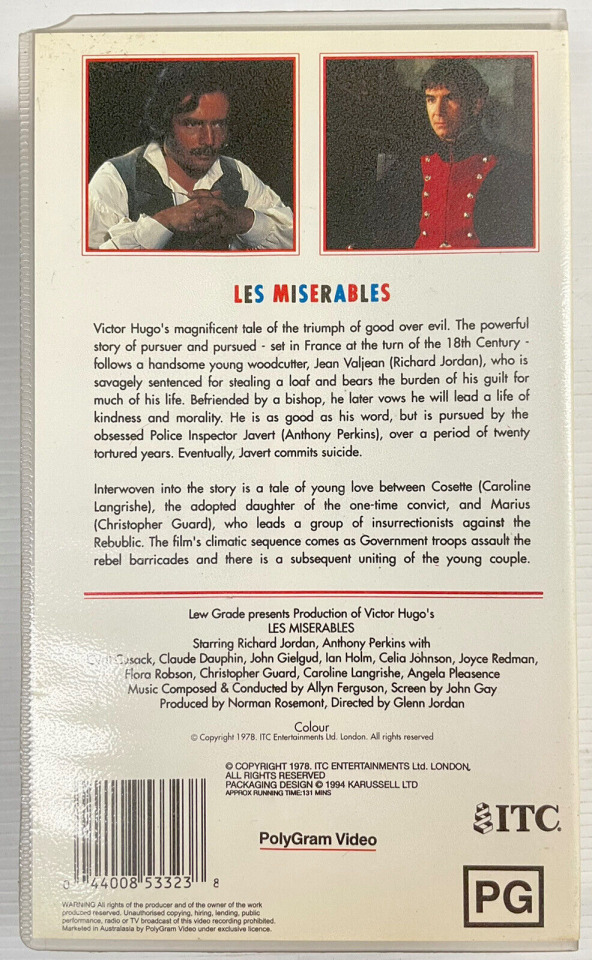
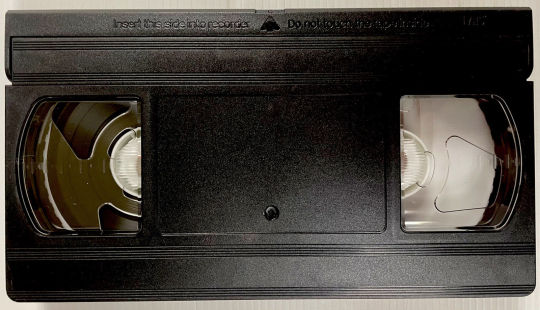
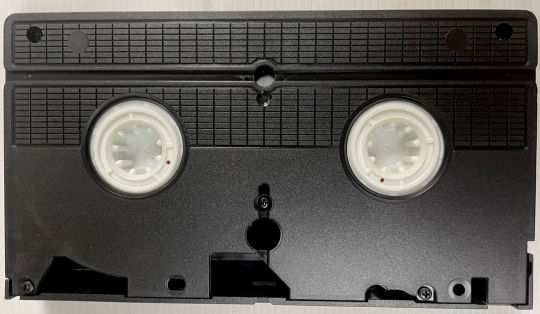
Les Misérables (1978) on VHS
#1978 fans is your collection even complete if you don't own it on VHS??#les miserables#lm 1978#simply follow the link to purchase this from ebay#lm ephemera
32 notes
·
View notes
Text
Some Curious Relics of Victor Hugo
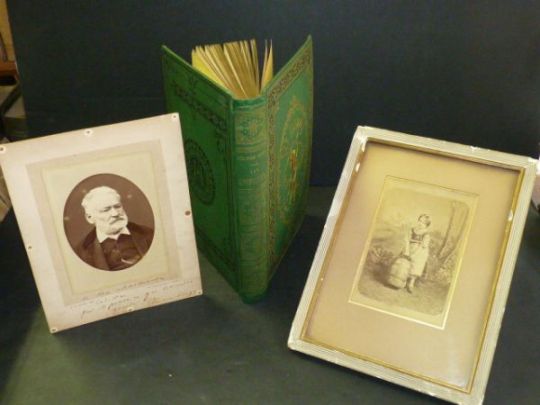
Apropos of Victor Hugo, there has been installed in the foyer of the Theatre des Nations, a curious collection of relics of the defunct poet, including not only the pen that he was accustomed to use, but also a tin lantern that he was wont to light his steps with at night during his sojourn to Guernsey. The great curiousity of the exhibition is a series of the poet's drawings. They are wild, fantastic, and original, full of imagination, and showing a sort of tempestuous ardor in the execution. Had not Victor Hugo been born a great writer he would have rivaled Gustave Dore on his own ground. But he was destined to write "Les Miserables," not to illustrate Dante.
There are a number of portraits shown, representing the poet from his earliest days to the close of his career. They look for the most part strangely unfamiliar to those who have only known "the old man eloquent" in these latter years. The massive head, sublimely picturesque with its snowy framework of profuse locks and ample beard, is hardly to be recognized in the smooth-faced young man with the dome-like brow that wrote "Hernani" and "Marion Delorme." He did not let his beard grow until he was 65. The letters and autographs shown in glass cases are especially interesting. One of these is the dedication of "Les Miserables" to the child actress, little Daubray, who played Cosette in a dramatic version of the work.
Source: the Greencastle Times, 18 February 1886
The above image isn't from 1886 (obviously) but I thought it paired well with the story; you can read more about it here. The book is Les Enfants, with a dedication to Daubray, not Les Miserables. Anyways, just thought it was interesting and I love to find a mention of Cecile Daubray because I just think she was cool.
14 notes
·
View notes
Text


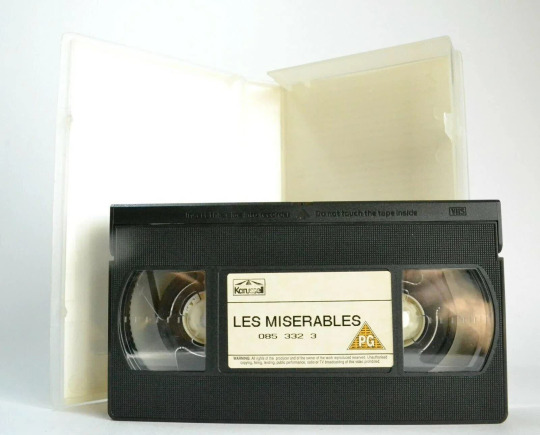
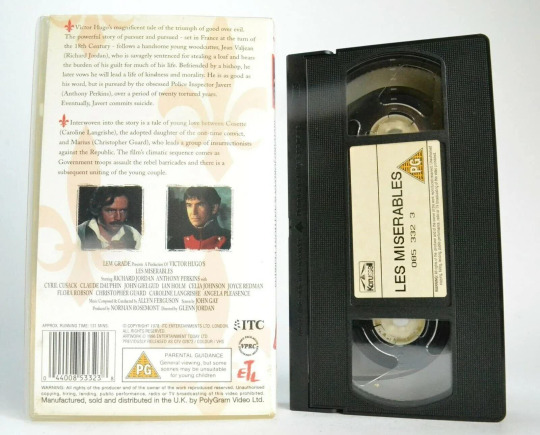
Les Misérables (1978) on VHS
#I'm telling you#this could be yours!#les miserables#lm 1978#i am so easily entertained browsing ebay#lm ephemera
16 notes
·
View notes
Text

From the personal collection of Marilyn Knowlden (young Cosette) in Les Miserables (1935)
9 notes
·
View notes
Photo


Source: San Francisco Call, 8 March 1918
Also if you are curious about the headline about Lincoln, you can read more here.
Film Drama Is Said to Be Historically Correct in Every Detail
Before the end of the world war thousands of Americans will have seen Paris —the Paris of Victor Hugo—for there have been no great changes in the sections which he describes in his works.
But for San Franciscans to see Victor Hugo’s Paris without braving the dangers of German U-boats, it is only necessary to visit the Rialto Theater next week, where will be shown a masterly picturization of “Les Miserables," the most melodramatic of all Victor Hugo's great melodramas, with William Farnum playing the part of the immortal Jean Valjean.
In “Les Miserables" nothing has been left undone to have it historically correct, even to the smallest details. A cross section of the streets of Paris, made from photographs and drawings and descriptions, was built “somewhere in New Jersey” for the making of the picture.
As an instance of the minuteness of detail and realism, the actual money of France during 1810 and I830 was used. Victor Hugo's story called for eight 20 franc gold pieces and nine 1 franc silver pieces. These coins are exceedingly rare and valuable now and were rented from a collector in New York. That the money is real is shown by the close-ups of the coins.
27 notes
·
View notes
Text

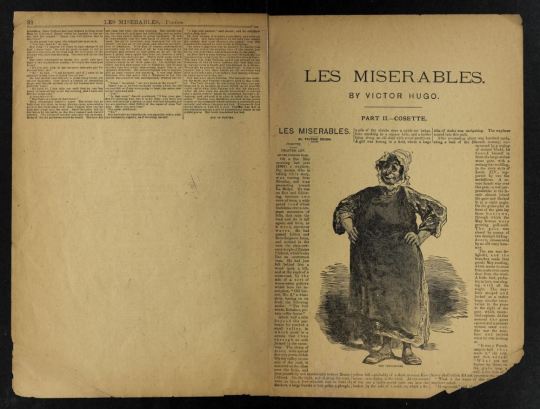

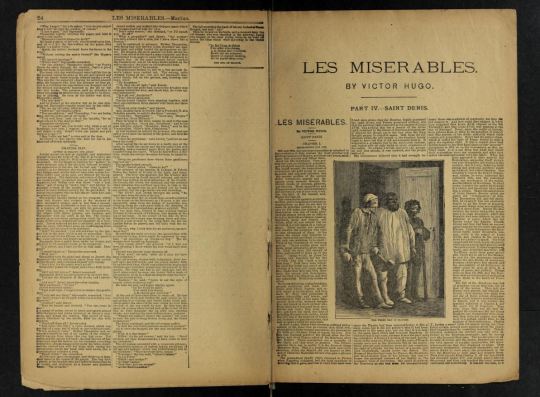
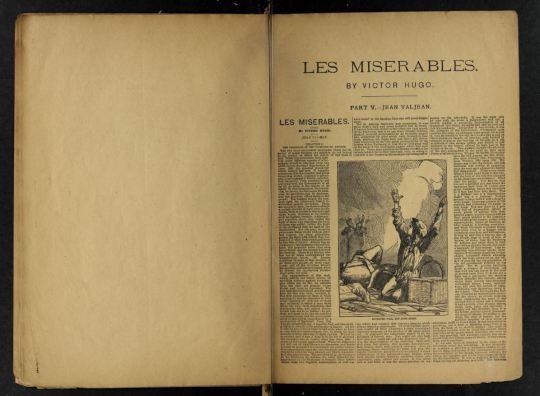
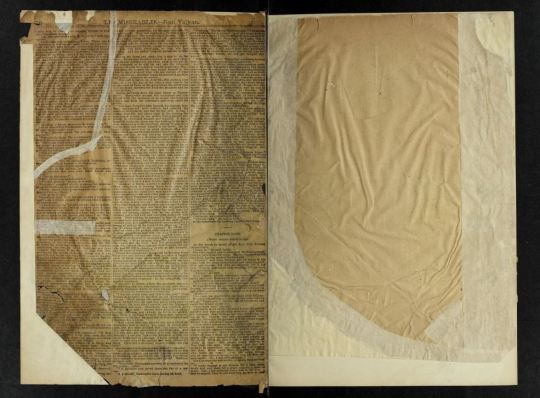
Source: Les Misérables, The Giant Series published by George Munro's Sons circa 1890
18 notes
·
View notes
Text
This is an excerpt from Fifty Years Among Authors, Books and Publishers (1884) by James C. Derby, who worked with George W. Carleton, the first (to my knowledge) publisher of Les Misérables in the United States.
The next successful venture was Victor Hugo's “Les Miserables,” and although we were in the midst of the Civil War, the book made a great hit. It was brought out with the same expedition as were Michelet's books, one volume at a time. The sale was not large at first, but the newspaper critics soon made it popular. Carleton spent ten thousand dollars in specially advertising it. He soon felt the effects of his enterprise in the extraordinary demand for hundreds of thousands of volumes. At the book trade-sale of George A. Leavitt & Co., one wholesale dealer purchased twenty-five thousand copies, — the largest sale, it is believed, ever made at auction of any one book.
In this connection a curious incident occurred. The immense popularity of “Les Miserables” had attracted the attention of a Cuban, who called upon Mr. Carleton one day and proposed to purchase an edition of the work if rendered into the Spanish language, the books to be shipped to Havana. The Cuban proposed to pay part of the cost in advance and the remainder on the delivery of the books. Carleton fulfilled his part of the contract, when the Cuban directed that the books should be sent downtown, where he desired them packed in hogsheads [a cask for holding wine].
This extraordinary proposition aroused Mr. Carleton's suspicions. He at once demanded the balance of the money due or return of portion of stock. The latter request was more than fulfilled. One can imagine Mr. Carleton’s surprise when the drayman brought to his store sixteen hogsheads! He had them stored, expecting daily to hear from the Cuban, who did not put in an appearance, however. The hogsheads were then opened one after another, when it was found that Victor Hugo’s novel was the inside layer in each hogshead, which was, at each end, packed with glass lamp-chimneys! Thus, Mr. Carleton became an involuntary glassware merchant, spending a good deal of his time in selling lamp-chimneys. He realized, however, enough from them to remunerate him for the cost of the books.
The Cuban, who Mr. Carleton says, was a fierce, piratical looking customer, was never again heard of. It is supposed that this enterprising Spanish merchant took this method of smuggling the books into Havana, because the importation of Victor Hugo's works had been interdicted by the Spanish government.
11 notes
·
View notes
Video
youtube
I spent an afternoon (or two) transcribing this 1865 song called Enjolras, The Song of the Patriot (dedicated to the immortal memory of Abraham Lincoln) so that you could hear it. Please enjoy. You can find my transcription here.
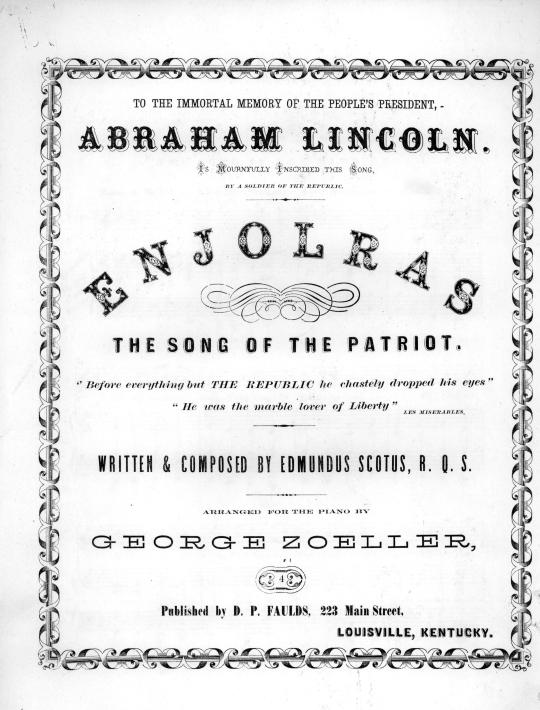
69 notes
·
View notes
Photo
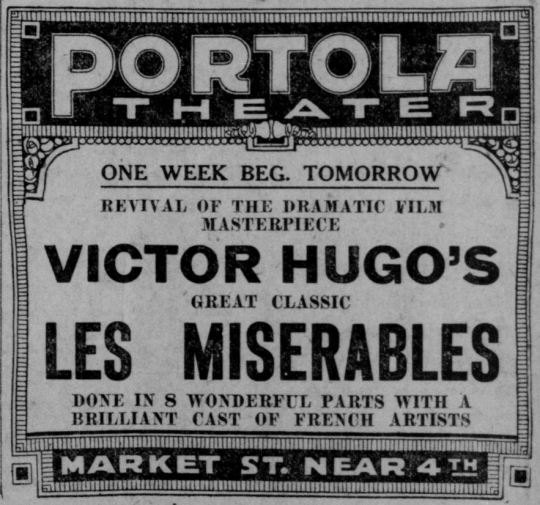
Source: San Francisco Call, 8 September 1917
15 notes
·
View notes
Text

Paul Collin's sketches of the costumes for Les Miserables
Pour Vous, 18 May 1933
Collin's reportedly designed 300 costumes for the film. He said:
I took a keen interest in this job. Raymond Bernard gave me carte blanche to do whatever I wanted, and I'm very grateful to him for that. I reread Les Misérables, analyzed every figure, every character, and designed the costume to suit the individual's nature as I saw it. I believe that when it comes to recreation, it's more important to make things come alive than to observe historical accuracy. We have to imagine the characters as they live in our imagination, not as documents immobilize them.
I also took into account the physical traits of the characters. A bourgeois, a bougnat, or a clerk all have particular physical characteristics. Each of my drawings contains an indication that has often made it easier for Raymond Bernard to choose his extras, and I see, in this working method, a useful collaboration between the artist and the director.
6 notes
·
View notes
Photo
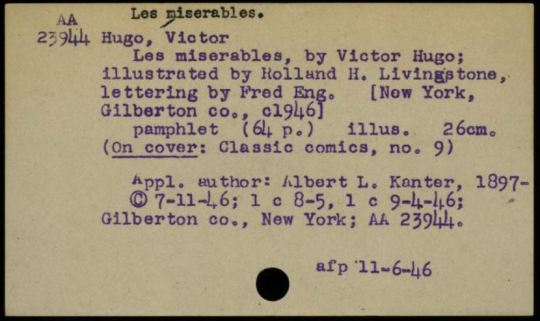
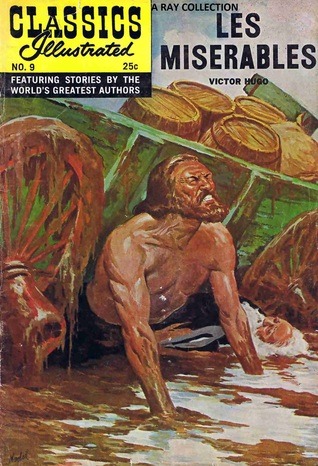
Copyright registration cards from the United States Copyright Office for the Classics Illustrated version of Les Misérables [source]
If you want to see the Classics Illustrated version for yourself, go here
11 notes
·
View notes
Text

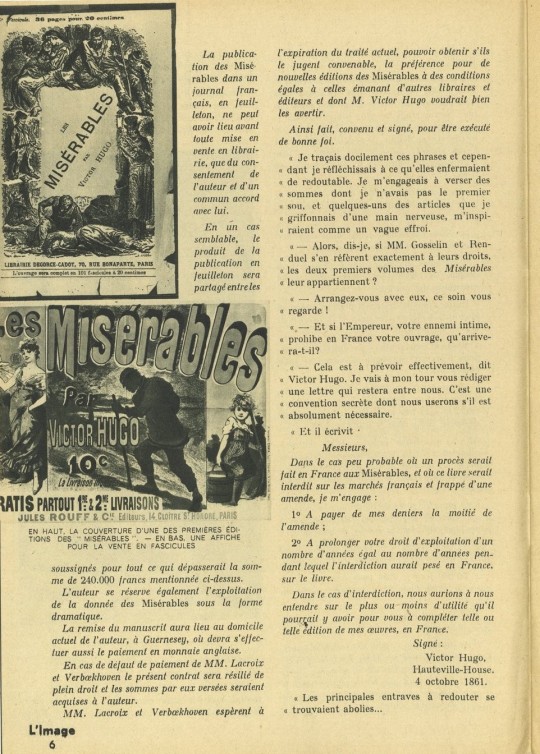

A short history of the publication of Les Miserables published in L'Image, ahead of the premier of the 1934 movie adaptation directed by Raymond Bernard. I like the pens in the third image, which are allegedly the ones Hugo used while writing Les Mis.
For more information on the book's publication, see the interview with Albert Lacroix in L'envers de la gloire in which he shares some thoughts on his (then) unpublished correspondence with Hugo (and Mme Lacroix recalls Hugo's 60th birthday party). Or you can read Hugo and Lacroix's letters in Leuilliot's Victor Hugo publie Les Miserables
2 notes
·
View notes